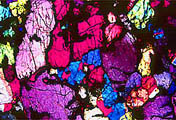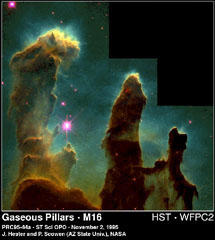




Meteorites to Interstellar Gas Clouds
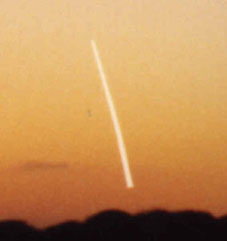 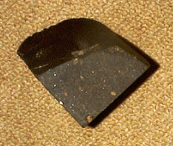
Right) A cut piece of the Parnallee meteorite, which is a carbonaceous chondrite. It still has a slight sweet smell of organic solvent. Courtesy of the Natural History Museum, UK. © John Hodges, 2000 (Left) A meteor fireball from the 1998 Leonids meteor shower. © John Hodges, 1998 There are four main types of meteorite. Three are metallic or rocky in nature, but the fourth is high in carbon compounds, some of which are organic. These carbonaceous chondrites, as they are known, are rich not only in carbon but in organic hydrocarbons and amino acids. Though none of these organics has yet been proven to be alive (or even dead - implying it was once alive). Comets leave tails of dust and ice. If the Earth passes through them we can usually see a meteor shower. The microscopic particles burn up as they strike the upper atmosphere, leaving a distinct trail in the sky. The colors vary and can give an idea of the composition of the the meteor. Occasionally, the color suggests the presence of organic compounds.
|
|
(Above)
Asteroid meteorite. Certain times of the year the Earth passes through the tails of comets and this can sometimes result in a spectacular meteor shower. Meteor trails can vary in color, and this can sometimes give an indication of the probably chemical composition of the meteor, which is a tiny ice or dust particle the size of a sand grain. Attempts have also been made to record the spectrum of meteor trails. This gives a much more reliable result, and though many meteors are found to be water or silica, some have proven to be made of carbon, and carbon compounds. Some of these latter spectra indicate the presence of organic matter. Could a meteor contain bacteria or viral strands? |
|
©
1995-2000 by Michael W. Davidson and The Florida State University.
|
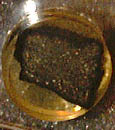 (Left) A section through a fragment of the Murchison Meteorite, courtesy of the Natural History Museum, UK. © John Hodges, 1999 In September 1969 one of the most important meteorites ever discovered fell near the town of Murchison in Australia. It broke up in the atmosphere and fragments rained down. Many of these were recovered. The rock was black and had a strange texture. It also smelled of methylated spirit. Samples were sent to the University of Melbourne and the meteorite was identified as a carbonaceous chondrites, rich in organic material. It is thought to be the fragmentary remains of an extinct comet. Amino acids were found in the meteorite, identical to those commonly used in life processes. But some amino acids in the meteorite were chirally right-handed, and not common to terrestrial life. Left-handed molecules outnumbered right-handed molecules by a significant number, though, so speculation mounted as to whether or not the organic residues in the meteorite were of biological origin. The question remains open, however, for it is possible to create such molecules by purely physical processes as well as biological ones. |
|
|
So while the Murchison meteorite raised questions about there being life in deep space, it did provide categorical evidence that complex organic compounds do exist and probably form in deep space. That was until very recently.  (above) A fragment of the Allende Meteorite, courtesy of the Natural History Museum, UK. © John Hodges, 2000 In late January 2000 the findings of research on several carbonaceous chondrites was reported at a conference in Denver, Colorado. The interiors of pieces of the Murchison, the Efremovka and the Allende meteorites have been examined by Dr Stanislav Zhmur and Lyudmila M. Gerasimenkoof the Russian Academy of Sciences. Their results are as spectacular as we saw with the famous "life-bearing" Mars Meteorite, ALH84001. The images they showed, reveal six different types of microstructure in the meteorites which the claim are reminiscent of colonies of different cyanobacteria, in a fossilized state. They identify each structure with a specific Earth organism and point out that on Earth, these organism would live in water,"... probably in hydrothermal volcanic activity zones." Questions about how well living bacteria in a meteorite might survive entry into the Earth's atmosphere is being addressed by a group of European scientists which includes Professor Colin Pillinger. They are planning to create an artificial life-carrying meteorite. Go to Life
on deep space |
![]()
David
Deamer - article
David
Deamer - personal
Create
space! - making vesicles
the
process - a vesicle
Go
to
Home
| Space Station
| Mars | Rainforest
© 1999 Satellite Events Enterprises Inc.
